Elite PC Titan FX: Setting New Standards in Gaming
by Wesley Fink on November 30, 2003 10:57 PM EST- Posted in
- Systems
Elite PC Titan FX: Chenbro Xpider Chassis
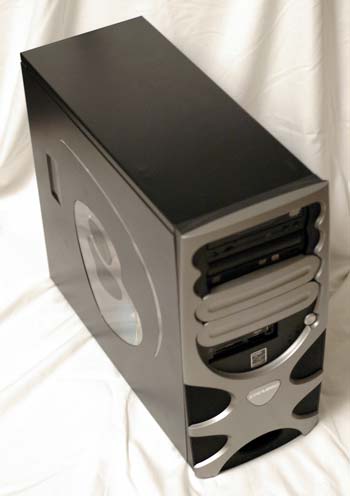
Elite PC uses the attractive Chenbro Xpider chassis for their Titan FX system. It is combined with a 460-watt power supply and offers outstanding expansion capabilities, particularly for hard drives. The silver and black case can mount up to 6 3.5" hard drives, and easily handles the 2 Western Digital Raptor 10,000RPM drives in a RAID 0 array. A front mounted fan blows intake air across the hard drive cage to cool the drives.

The Titan FX uses black drives and peripherals to match the case.
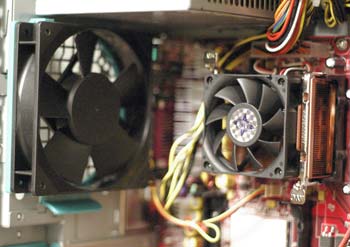
Elite PC uses a huge 120mm fan for output air on the Titan FX. Large fans like this can turn at slow and quiet rpm, but still move massive amounts of air for cooling. Generally they are a better solution than small, noisy fans that must run at high rpm to move much air.

The Titan FX provides the see-thru side window seen on many gaming systems these days. It is also equipped with a Blue Neon case light.
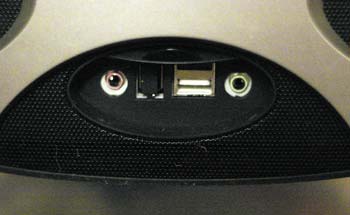
Inside a front lift-open door are the front jacks, which include 3 USB, firewire, headphone and mic jacks.
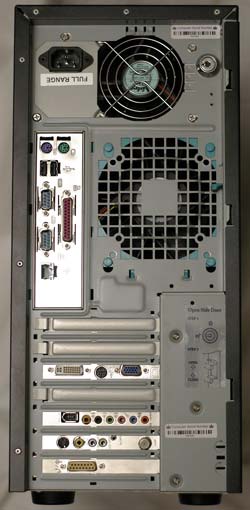
With the motherboard, ATI Radeon XT, Creative Audigy 2, and MSI TV@nywhere card, there are a plethora of jacks on the rear panel. You get 2 more USB 2.0 jacks, the full complement of Audigy 2 audio I/O, digital and analog outputs on the ATI 9800 XT, video ports on the TV card, 10/1000 LAN port, parallel, and 2 serial, game and PS2 mouse/keyboard ports. The incredible selection of available ports on the delivered Titan FX should satisfy just about any expansion need.

Getting into the Titan FX case is fairly simple, since it is a screw-less design. Slide a lever at the left rear and the entire left side panel can be removed. The standard system is loaded with top-line components, as you can see in this photo.
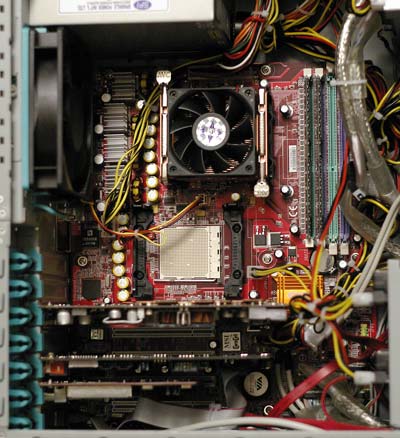
With the case open, you get a good view of the simple, but effective, cooling system for the Athlon64 FX51. Cooling air is pulled into the case by an 80mm intake fan at the bottom front of the case. The CPU itself is cooled by an AVC/MSI heatsink-fan with thin copper fins and a 70mm fan. Hot air from the system is exhausted at the upper rear by a 120mm fan. While we did not measure noise level, the whole system is on the noisy side as shipped. Most of the noise is generated by the 120mm fan, which is turning at a much higher rpm than is necessary. We would strongly suggest using the Smart Fan features in the PC Health section of the BIOS to tie the 120mm fan to system temperature. Just doing this drops noise levels substantially without compromising system temperature. The good side to the high-speed 120mm fan is that you do have the option to move massive amounts of air for system overclocking.










50 Comments
View All Comments
sprockkets - Tuesday, December 2, 2003 - link
Adding, but how much of the system actually follows industry standards. Like why would I want a D/Hell with a stupid bios that is worse than features included even on uATX boards?sprockkets - Tuesday, December 2, 2003 - link
The power supply is FSP, and unlike the stupid dell is not proprietary. FSP are known for making good PS. Like the ones with the 120mm fans inside them.Of course the p4 systems can be faster with the RAID setup but neverless impressive. You should compare not only the specs and scores.
Wesley Fink - Tuesday, December 2, 2003 - link
Doop - While AMD has stated from the beginning that the FX would not be multi-processor capable, MANY reviews have speculated that the shipping FX chips did not, in fact, have the 2nd and 3rd HT links disabled. If links were not disabled, then the chips WOULD work in a dual-processor board. Manufacturers tell us many things, but we still prefer to find out for ourselves, because things often turn out not to be exactly what we have been told by manufacturers.Now that we have tested this for ourselves, the article has been corrected. We have also added the recommendations from Elite PC on multiple CPU selection to the review, and I have just received a written response from AMD. We have done our best to answer the question with hands-on testing in a timely manner, and post the information as soon as it is available.
I also read many other sites, and I don't recall an actual attempt to run 2 FX51 chips being reported. The question has never been AMD's intention with FX, but there have been many questions as to whether the other two HT links were actually being disabled on FX chips. We can now say that on FX chips we have tested, Dual-Processor operation with FX chips did not work, and the Opteron 2 and higher series should be used for dual processors.
Doop - Tuesday, December 2, 2003 - link
tfranzese, not many people think the Athlon FX is dual capable. AMD has clearly stated that they are not. This article was clearly not up Anandtech's usually extremely high level.Now this is purely wild speculation on may part but it could be possible that you get higher yeilds of opteron cores if you accept some with not all the functioning hypertransport links.
Just like Radeons with 4 instead of 8 pipelines.
You could enable the hypertransport links but there is possibility that you've got a chip where the links needed for dual operation will never work.
tfranzese - Tuesday, December 2, 2003 - link
I don't think it's been clear, because I and others were under the assumption that they were not disabled in an effort to get them out asap. Might have just been engineering samples though, because these assumptions came from an article.Shinei - Tuesday, December 2, 2003 - link
Uh, tfraneze, I'm pretty sure it's been clear since the start that the FX-51 has had and always will have two disabled HT links... Turning them on MIGHT be possible, but that depends on how much time and money you're willing to waste (since a mistake can cost you $800).Shinei - Tuesday, December 2, 2003 - link
Uh, tfraneze, I'm pretty sure it's been clear since the start that the FX-51 has had and always will have two disabled HT links... Turning them on MIGHT be possible, but that depends on how much time and money you're willing to waste (since a mistake can cost you $800).tfranzese - Tuesday, December 2, 2003 - link
Locutus, the board is a design that uses only one memory controller to cut down on traces. There's a recent article, I think from GamePC that compares it with an Extended ATX dual board with use of both memory controllers.Wesley Fink - Tuesday, December 2, 2003 - link
#31 - The board is located on the MSI site under 'server workstation' at http://www.msi.com.tw/program/products/server/svr/... As stated in the review the board is the VIA K8T800 chipset.Locutus4657 - Tuesday, December 2, 2003 - link
I couldn't find this motherboard on the MSI web site. But to me it looks like this is a dual system using a via chipset? If so I didn't think this was possible... Or at the very least sane. Could some one confirm this?